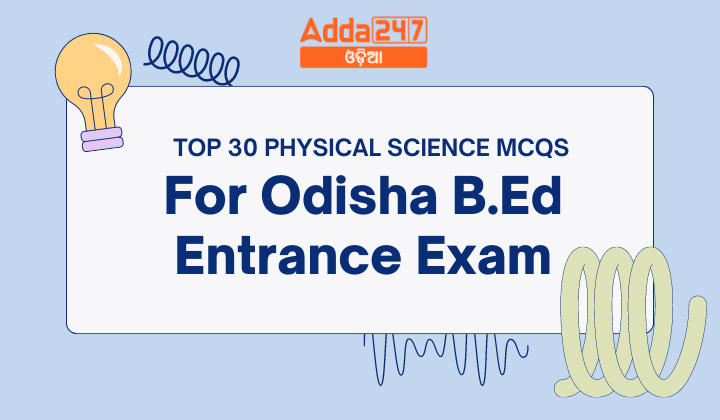Preparing for entrance exams requires a comprehensive understanding of the subject matter and thorough practice. For those aspiring to pursue a Bachelor of Education (B.Ed) in Odisha, mastering the fundamentals of Physical Science is crucial. To aid in your preparation, here are the top 30 Multiple Choice Questions (MCQs) in Physical Science tailored for the Odisha B.Ed Entrance Exam:
Top 30 Physical Science MCQs For Odisha B.Ed Entrance Exam
- What percentage of known elements are metals?
(a) 50%
(b) 60%
(c) 78%
(d) 85%
Ans. (c) - Which of the following is NOT a characteristic of metals?
(a) Good conductors of heat and electricity
(b) Brittle
(c) Shiny
(d) Malleable
Ans. (b) - Where are non-metals primarily located on the Periodic Table?
(a) Left side
(b) Center
(c) Right side
(d) Throughout
Ans. (c) - Which element is NOT a metalloid?
(a) Boron
(b) Silicon
(c) Sulfur
(d) Arsenic
Ans. (c) - Metalloids are often used in industries for their unique properties. Which of the following is a common use of metalloids?
(a) Insulation
(b) Conductors
(c) Semiconductors
(d) Lubricants
Ans. (c) - What is a compound?
(a) A mixture of elements
(b) A substance consisting of one type of atom
(c) A substance consisting of two or more different types of elements in a fixed ratio of their atoms
(d) A solution of elements
Ans. (c) - How are compounds represented?
(a) By their chemical formula
(b) By their atomic number
(c) By their symbol
(d) By their atomic mass
Ans. (a) - What does the chemical formula H₂O indicate?
(a) Two atoms of oxygen and one atom of hydrogen
(b) Two molecules of hydrogen and one molecule of oxygen
(c) Two atoms of hydrogen and one atom of oxygen
(d) One atom of hydrogen and one atom of oxygen
Ans. (c) - What type of bond holds the atoms together in molecular compounds?
(a) Ionic bonds
(b) Covalent bonds
(c) Metallic bonds
(d) Hydrogen bonds
Ans. (b) - Which of the following is a salt?
(a) H₂O
(b) NaCl
(c) NH₃
(d) CH₄
Ans. (b) - Which of the following is an example of a molecular compound?
(a) NaCl
(b) H₂O
(c) Al
(d) Pb
Ans. (b) - What defines an element?
(a) A substance that can be broken down into simpler substances
(b) A species of atoms that have different numbers of protons
(c) A species of atoms that have the same number of protons in their atomic nuclei
(d) A combination of two or more types of atoms
Ans. (c) - How many elements are naturally occurring?
(a) 24
(b) 94
(c) 118
(d) 54
Ans. (b) - What is an isotope?
(a) Atoms of the same element with different numbers of protons
(b) Atoms of the same element with the same number of neutrons
(c) Atoms of the same element with different numbers of neutrons
(d) Atoms of different elements with the same number of protons
Ans. (c) - Which of the following is an element?
(a) H₂O
(b) NaCl
(c) Si
(d) CH₄
Ans. (c) - What is the valency of Carbon (C)?
(a) 2
(b) 3
(c) 4
(d) 1
Ans: (c) 4 - Which element has a valency of 1?
(a) Oxygen
(b) Sodium
(c) Magnesium
(d) Sulfur
Ans: (b) Sodium - What is the oxidation state of oxygen in H2O2 (Hydrogen Peroxide)?
(a) +1
(b) -1
(c) -2
(d) 0
Ans: (b) -1 - The valency of an element in Group 2 of the periodic table is generally:
(a) 1
(b) 2
(c) 3
(d) 0
Ans: (b) 2 - Which of the following elements has an oxidation state of +3 and +2?
(a) Iron (Fe)
(b) Sodium (Na)
(c) Magnesium (Mg)
(d) Zinc (Zn)
Ans: (a) Iron (Fe) - In which compound does fluorine exhibit an oxidation state of -1?
(a) F2
(b) OF2
(c) NaF
(d) Both (b) and (c)
Ans: (c) NaF - Which element typically shows an oxidation state of +1?
(a) Potassium (K)
(b) Calcium (Ca)
(c) Boron (B)
(d) Silicon (Si)
Ans: (a) Potassium (K) - The valency of which element changes depending on whether it is in its elemental form or a compound?
(a) Neon (Ne)
(b) Hydrogen (H)
(c) Helium (He)
(d) Argon (Ar)
Ans: (b) Hydrogen (H) - What is the oxidation state of chlorine in Cl2?
(a) +1
(b) 0
(c) -1
(d) +2
Ans: (b) 0 - Which element belongs to the d-block and has a valency of 2 or 3?
(a) Zinc (Zn)
(b) Copper (Cu)
(c) Nickel (Ni)
(d) All of the above
Ans: (d) All of the above - Where does the phenomenon of reflection usually occur?
(a) Lenses
(b) Prisms
(c) Mirrors
(d) Transparent mediums
Answer: (c) Mirrors - How can reflection be simply defined?
(a) The bending of light when it passes through a medium.
(b) The bouncing back of light when it strikes a medium on a plane.
(c) The absorption of light by a medium.
(d) The dispersion of light into different colors.
Answer: (b) The bouncing back of light when it strikes a medium on a plane. - In refraction, what happens to the light entering the medium?
(a) It returns to the same medium.
(b) It is absorbed by the medium.
(c) It travels from one medium to another.
(d) It gets dispersed into multiple colors.
Answer: (c) It travels from one medium to another. - During reflection, how do the light waves behave?
(a) They bend and change direction.
(b) They pass through the surface and change medium.
(c) They bounce from the plane and change direction.
(d) They split into different wavelengths.
Answer: (c) They bounce from the plane and change direction. - What is the relationship between the angle of incidence and the angle of reflection in reflection?
(a) The angle of incidence is greater than the angle of reflection.
(b) The angle of incidence is less than the angle of reflection.
(c) The angle of incidence is equal to the angle of reflection.
(d) The angle of incidence is not related to the angle of reflection.
Answer: (c) The angle of incidence is equal to the angle of reflection.
















